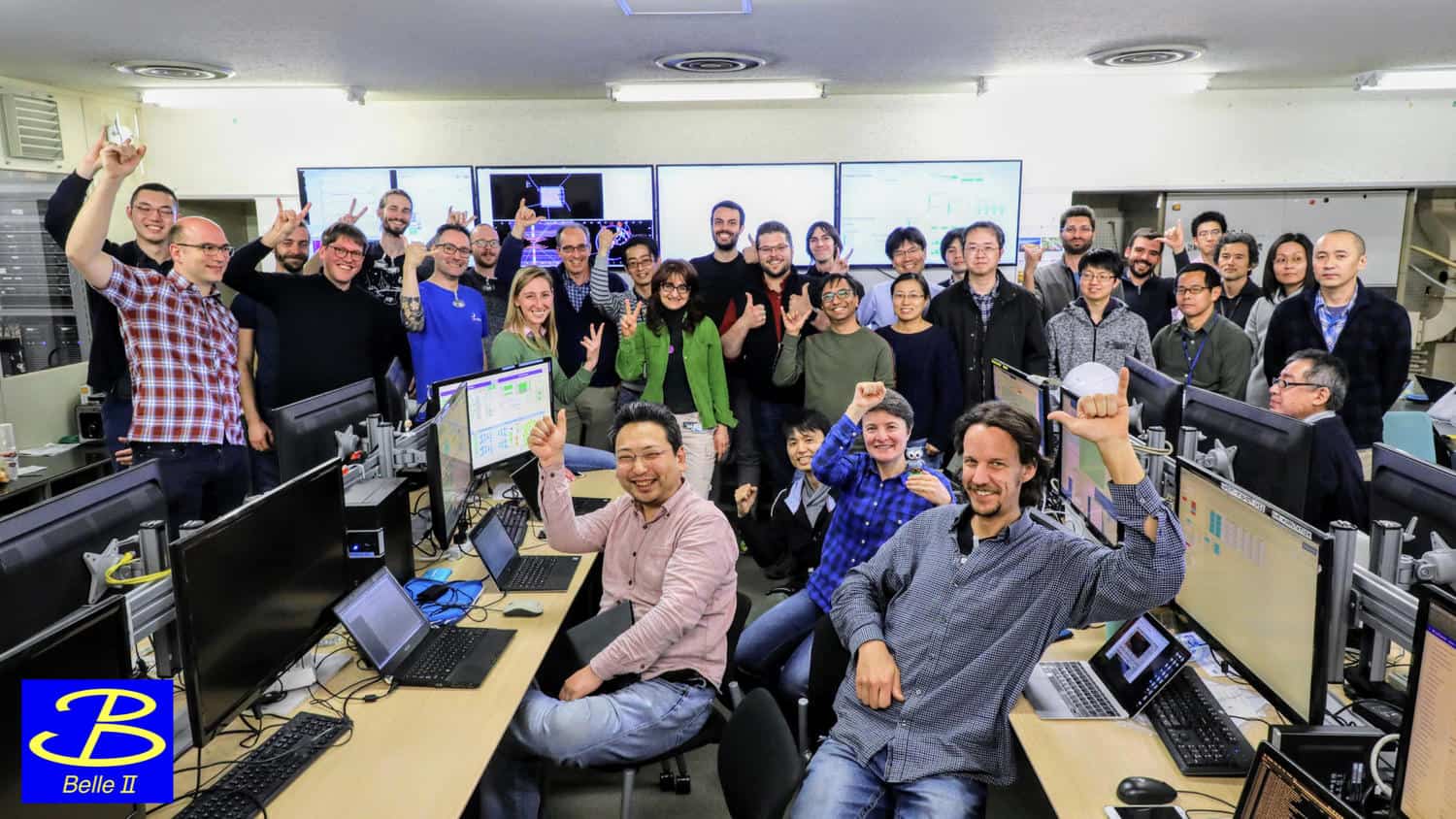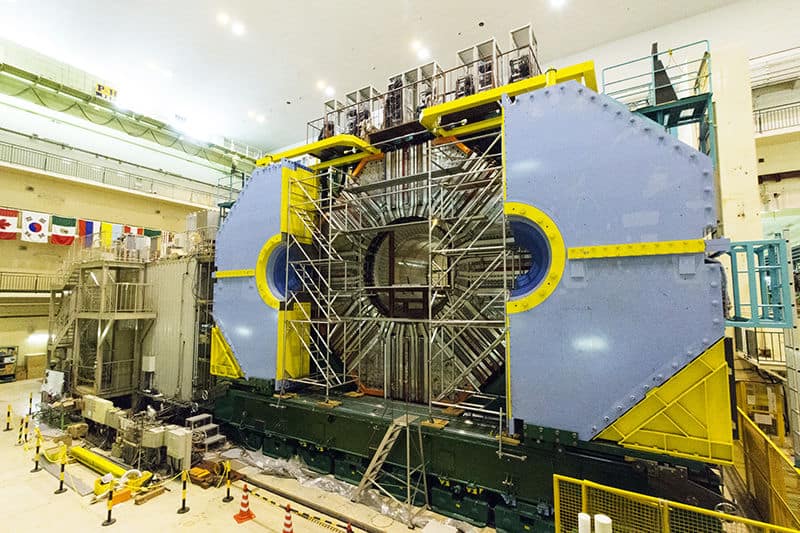Belle II experiment is smashing particles together for the first time. It is one step closer to unravel the mystery of antimatter.
Belle2
Belle II rolls-in to SuperKEKB
A search for new physics: The Belle II experiment
At the beginning of the universe there were equal quantities of matter and anti-matter and yet 13.7 billion years later, the universe is completely dominated by matter. How did this happen? Asymmetries in the interactions of fundamental matter particles and their anti-matter counterparts are likely to be responsible for the matter dominance of the universe and our own existence. However, the known asymmetries do not seem to be sufficient and seem to require new particles or new interactions beyond the Standard Model of Particle Physics. A team of University of Hawaiʻi at Mānoa Department of Physics and Astronomy researchers and those from 23 nations seek to answer these questions and other mysteries of the Universe with the Belle II experiment.
A milestone was reached on April 11 as the Belle II detector was “rolled-in” to the collision point of the SuperKEKB particle accelerator. The UH Belle II team plays a leading role in the beam background commissioning detector (BEAST II) and the readout systems of the iTOP (imaging Time Of Propagation) detector and the KLM (KLong Muon) detector. Following the roll-in, the UH team is preparing for the 2017 summer cosmic ray run in which all of the components of the Belle II outer detector are integrated. The first run with collisions of the electron and positron particle beams will start in February 2018.
The term “roll-in” refers to the operation of moving the entire 1,400 ton Belle II detector system, following the completion of the assembly and integration of the various components, from its assembly area to the beam collision point. The Belle II detector and the SuperKEKB accelerator are now an integrated unit.

Workers at KEK celebrate the completion of Belle II roll-in (image copyright: Belle II/KEK)
International team explores the beginning of the universe
The Belle II experiment is an international collaboration hosted by KEK in Tsukuba, Japan. Using a state-of-the-art experimental apparatus, Belle II explores the mysteries of the beginning of the universe. The Belle II detector precisely measures elementary particle interactions artificially created with the upgraded SuperKEKB accelerator.
- Related: Belle II super-B factory experiment takes shape at KEK, CERN Courier, August 12, 2016
In the Belle II experiment, researchers will observe various elementary particles generated from high energy electron-positron collisions using the 8-meter tall Belle II detector consisting of seven types of subdetectors and investigate the various kinds of elementary particles that emerge from these collisions. The detector will provide measurements of the directions, momenta and energies of the newly produced particles. Compared to the earlier Belle experiment, Belle II has much improved measurement precision and can handle an order of magnitude higher rate from accelerator induced background.
More than 700 researchers from around the world participate in the Belle II experiment. Their goal is to find a significant “deviation” from the Standard Model of particle physics and perhaps determine which of the many proposed new theories describes the world of elementary particles.
UH Mānoa Professors Tom Browder, Sven Vahsen and Gary Varner along with other UH Mānoa postdoctoral researchers and graduate students participated in the first Belle experiment at Tsukuba, Japan’s KEK B factory. It is celebrated for its critical role in experimentally verifying the theoretical scheme of Kobayashi and Maskawa, winners of the 2008 Nobel Prize in Physics.
Browder is now the Belle II spokesperson, Vahsen is leading the BEAST II beam background group and Varner is leading the U.S. readout electronics efforts. UH Mānoa is responsible for major components of the Belle II particle identification readout systems using Varner’s renowned “oscilloscope on a chip” application specific integrated circuits (ASICs) as well as the BEAST II background commissioning system, which detects neutrons with Vahsen’s innovative micro-time projection chambers
In addition to the three UH Mānoa faculty members, current members of the Belle II project are postdoctoral scholars Oscar Hartbrich, Dmitri Kotchetkov, Peter Lewis, Tobias Weber and engineers Matt Andrew, Isar Mostafanezhad and Luca Macchiarulo and graduate students Shawn Dubey, Michael Hedges, Chris Ketter and Ilsoo Seong.
Belle II collaborators
The other U.S. institutions collaborating on Belle II are Carnegie-Mellon University, University of Cincinnati, Luther College, Kennesaw State, Indiana University, University of Pittsburgh, University of South Alabama, University of South Carolina, Virginia Polytechnic Institute, Wayne State University and Pacific Northwest National Lab.
UH Physics Prof. Varner
UH Physics Prof. Gary Varner has received the 2016 DPF Instrumentation Award

The Division of Particle and Fields (DPF) of the American Physical Society has honored University of Hawai’i at Manoa Physics Professor Gary Varner with the 2016 Instrumentation Award for Experimental Particle Physics.
The award citation reads “For the development of technologies for detection of signals in frontier experiments, especially [the fully depleted charge coupled device] and the ‘oscilloscope on a chip’ integrated circuit.”
This is the second DPF instrumentation award. Prof. Varner shares the award with Dr. Stephen Holland (Lawrence Berkeley National Laboratory). Last year’s award went to Prof. David Nygren (University of Texas at Arlington) and Dr. Veljko Radeka (Brookhaven National Laboratory).
The 2016 DPF Instrumentation Award recognizes Gary Varner’s development of state of the art “oscilloscope on a chip” ASICs (Application Specific Integrated Circuits) and associated readout systems, which have had considerable impact on experiments in high energy and astroparticle physics.
Professor Varner’s readout systems play a critical role in the Belle II experiment located at the KEK laboratory in Tsukuba, Japan. In particular, his IRSX ASIC readout chip, which has a timing resolution of below 50 picoseconds is the basis of the readout system for the Cerenkov particle identification system called the iTOP (imaging Time Of Propagation) detector. Gary Varner not only developed the readout ASIC matched to the pixelated photosensors of the device but the full readout system and the methods for calibration. He also designed and built the TARGETX waveform sampling ASIC, which is the basis of the readout system for the Belle II KLM (K-long and
muon) system.
It is quite remarkable that in addition to his critical contributions to accelerator based experiments, Professor Varner has also developed readout systems based on his fast deep pipeline multi- channel oscilloscopes on a chipfor the ANITA astroparticle missions and for a variety of other experiments (such as the UH-led TimeCube experiment). In all these cases, his contributions were critical to the success of the experiments and the physics results.
In addition to his scientific accomplishments, Professor Varner has mentored and trained an entire generation of graduate students, postdocs and engineers. This is a critical contribution to the entire field of high energy physics.
Varner received a BS in Electrical Engineering from Boston University (BU), a master’s degree from BU in Physics and a Phd in Physics from the University of Hawai’i. He has worked in academia and industry. He was appointed as assistant professor of physics at UH Manoa in 2005 and was promoted to the full professor rank in 2015. While at UH, he received three DOE (Department of Energy) ADR (Advanced Detector Research) awards and a large number of external grants.




